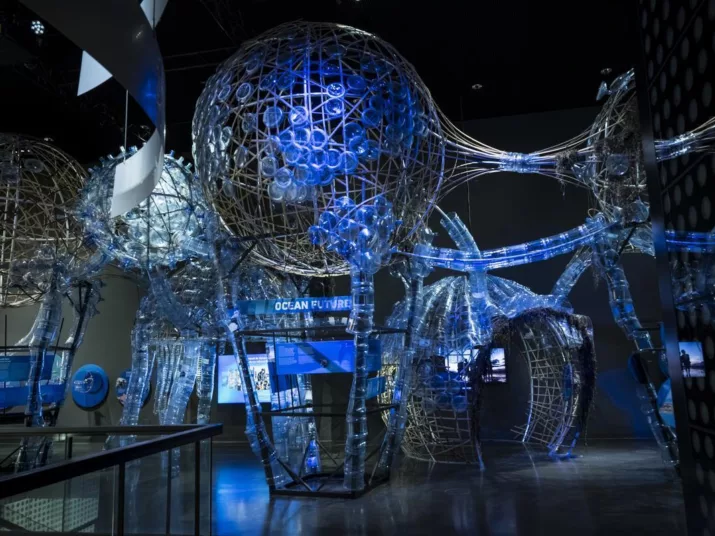
Photo: Stefanie Loos
Balangay Spacecraft: From water We Build
At Futurium, artist Leeroy New presents “Balangay Spacecraft,” an installation exploring community, ecology, and the evolving relationship between humans, water, and technology. Online editor Ludmilla Ostermann spoke with the contemporary Filipino artist about the origins of the title, materials, and what it means to be a citizen of the ocean.

Photo: Stefanie Loos
Balangay Spacecraft – what is the title about?
Leeroy New: “Balangay” is our word for ancient boats in the Philippines. Over time, it became barangay, which now means community or village. So, our idea of community is rooted in our life on water. These boats have an organic look, and my work connects to that evolution — how our relationship with water has shaped how we build and live. I once built something similar by the beach, so this piece continues that story indoors.
Is this the first time you’ve brought the concept indoors?
New: Yes. Most of my projects are public installations, so showing something in a crafted, indoor space like Futurium is a new challenge — but it still feels public in spirit. There’s constant movement and engagement here.
My goal is to see how creative practice can contribute to urgent environmental issues.
Does this setting at Futurium inspire you differently?
New: Definitely. I’ve worked in the art world my whole life, but I’ve always wanted to move toward science and technology — to make art a vessel for exploring innovation. My goal is to see how creative practice can contribute to urgent environmental issues like the climate crisis.
The title references space. How does a sea vessel become a spacecraft?
New: I grew up loving science fiction — The Fifth Element, Hayao Miyazaki’s Nausicaä of the Valley of the Wind — worlds full of fantasy and handmade futurism. But most sci-fi comes from first-world economies. I began asking: Where do we, in the Philippines, fit in those futures? Instead of just consuming sci-fi, I wanted to create my own language for it. But this installation is also a critique. The Philippines often receives the world’s waste. I imagine: if that continues, what kind of future would emerge? We’re resourceful people; we reuse everything. In our fiestas that are celebrating patron saints, local history, or cultural traditions, we turn discarded materials into colorful decorations. That’s where I draw from — transforming the grim reality of plastic waste into something that still celebrates life.
Leeroy New is a contemporary Filipino artist.
Photo: Leeroy New
You use recycled or found materials. Do they follow your vision or shape it?
New: They shape it completely. Each place has its own waste and systems of disposal. In the Philippines, because we lack potable tap water, plastic containers are everywhere. That abundance became part of my visual language. I began combining bamboo — a sustainable material — with plastic to form hybrid, biosynthetic structures. Sculpturing can be wasteful, so I challenge myself to use what already exists. Visiting recycling centers — like BSR here in Berlin — lets me understand how societies deal with waste and how those systems reflect their values.
Your installation feels both utopian and cautionary. How do you balance beauty and critique?
New: In the Philippines, art has never been separate from life. We don’t even have a direct word for “art” in the Western sense — it’s embedded in rituals, textiles, and tools. Tattoos once mapped the underworld; carvings carried beliefs. That’s why I do public art — to connect with people outside museum spaces. Our culture values craftsmanship and color. Even when themes are grim, we create beauty. It’s in our nature to decorate, to celebrate — look at our fiestas! My work carries that same energy, though in a quieter way.
Working abroad, I see that these struggles aren’t isolated.
The special exhibition “Ocean Futures” connects Berlin and Manila through shared experiences of coastal life. What did you notice about how different cultures live with the sea?
New: They seem different but share parallels — especially in how waste has entered the water. In the Philippines, rising sea levels force people to rebuild their homes higher each year. Typhoons and floods are constant, and people are frustrated by mismanaged environmental projects. Working abroad, I see that these struggles aren’t isolated — they’re global, interconnected.
Finally, what does it mean for you to be a “citizen of the ocean”?
New: It means care — recognizing we’re part of a system that creates waste and imbalance, but also trying to imagine alternatives. My work is about regeneration and rehabilitation — creating spaces that can host life and community. One of my first “Balangay” structures by the beach was built from recycled water containers. Locals thought it looked like turtle eggs, connecting it to their conservation stories. That’s what I love most — when people project their own meanings onto the work.